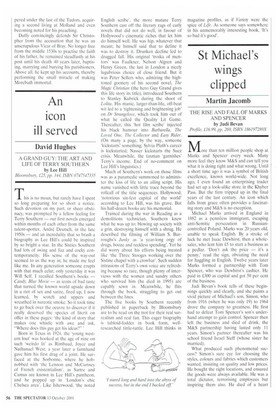Keeping the faith — and the accounts
Gerard Noel
THE VOICES OF MOREBATH: REFORMATION AND REBELLION IN AN ENGLISH VILLAGE by Eamon Duffy Yale, £16.95, pp. 232, ISBN 0300091850 T oday one can quite easily drive through the north Devon village of Morebath without realising it. It was not much of a place in the 16th century either, then as now, a tiny sheep-farming community on the southern edge of Exmoor. But thanks to Eamon Duffy's arresting new book, the names of the eponymous village and its vicar from 1520 to 1574, Sir Christopher Trichay (pronounced 'tricky), are surely destined to become familiar to any serious student of what the author justly calls the most decisive revolution in English history.
Throughout the 54 momentous years of his incumbency, Sir Christopher kept the parish accounts on behalf of the churchwardens. Unlike the other 200 surviving sets of churchwardens' accounts from Tudor England, the Morebath accounts 'packed with the personality, opinions and prejudices of the most vivid country clergyman of the 16th century', allow us to witness at first hand the effect of the unfolding drama of the English Reformation on the life of the man in the pew.
Decently educated but of humble origins, Sir Christopher was no knight, still less baronet (priests were called `sir' not 'father' in those days). Probably in his late twenties when he arrived in Morebath, the new vicar was pleased to have the modest £8-a-year stipend, which put him on about the same level as most of the 33 households of the parish, made up of tenant farmers and a handful of cottagers. It is clear, though, that even the poorest played a full part in parish life. Of the 55 taxpayers listed in 1524, 35 can be shown to have held parochial office subsequently.
Indeed, the communal life of Morebath made heavy demands of its people. Twice during the 1530s the vicar found himself at loggerheads with his flock over the prickly issue of the parish clerk's wages. But, on the whole, the energetic young priest, with his penchant for local saints and enthusiasm for the cult of images, was in tune with the traditional taste of his parishioners. Duffy happily characterises the pre-Refor
mation parish life of Morebath as one of 'busy piety', with the church, patriotically dedicated to St George, at the heart of the village's social and spiritual existence.
Sir Christopher's pet project was a fund to acquire a set of black vestments to be worn at requiem masses. In 1547, after a 20-year wait, Sir Christopher, 'beside himself with pleasure', was able to commission the vestments. The priest's joy was shortlived. By the end of the year, Edward VI, the ardently Protestant boy-king, was on the throne. Within two years the Catholic peasantry of Devon would be in a state of open revolt. And the wearing of black by clergy would be castigated by the Church authorities as 'monkish'.
Hitherto it has been assumed that the parish of Morebath was not involved in the so-called Prayer Book rebellion of 1549. Duffy's unblinking scrutiny of the parish accounts has now revealed that the parish equipped and financed a group of five young men to join the rebels in the camp outside Exeter. Astonishingly, Sir Christopher's records even disclose their names and the names of the people who paid for them. Only two of Morebath's sons returned, the other three fell alongside the 4,000 men butchered by Lord Russell's largely mercenary army.
Although it had taken 15 years from the passing of the Act of Supremacy in 1534 for the patience of this 'most law-abiding of villages' to finally snap, it is apparent that the impact of the Reformation from the outset on Devon's parishes had been as profound as it was unwelcome. But it is equally apparent that the parishes were in no position to resist change. Bishop Verey of Exeter was an absentee who, in common with most of the Henrician episcopate, acquiesced in every one of Henry VIII's moves against the church. Moreover, the dissolution of the monasteries, much resented in Devon, meant that ownership of many parishes such as Morebath was transferred from religious orders to upwardly mobile Protestant gentry.
It was not just the old ways which came under attack in these turbulent times but the very institution of the parish itself, which Tudor monarchs, including Mary, increasingly harnessed to meet secular rather than religious obligations. The parish of Morebath was virtually bankrupt by the time Mary came to the throne in 1553 and Sir Christopher was touchingly proud of the extent to which parish life was restored during her five-year reign, in which, incidentally, only one heretic was burned in the diocese of Exeter.
Although Elizabethan Anglicanism used Edward's prayer book, rejected images and detested the Pope, the abrasive zeal of her fanatical brother's regime was missing. Some pre-Reformation practices were revived. Women were churched and parish ales were drunk again. Remarkably, Sir Christopher not only survived but pros pered under the last of the Tudors, acquiring a second living at Molland and even becoming noted for his preaching.
Duffy convincingly defends Sir Christopher from the accusation that he was an unscrupulous Vicar of Bray. No longer free from the middle 1530s to practise the faith of his father, he remained steadfastly at his post until his death 40 years later, baptising, marrying and burying his parishioners. Above all, he kept up his accounts, thereby performing the small miracle of making Morebath immortal.



























































































 Previous page
Previous page